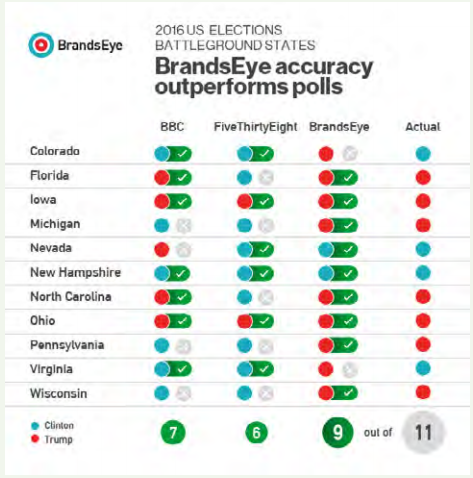4.10: Case study - Sentiment data mining predicts political outcomes
- Page ID
- 35248
One-line summary
BrandsEye, is an opinion mining company based in South Africa, who accurately predicted two significant political outcomes in 2016, outperforming traditional polling methods and showcasing the value of analysing social media analysis at scale.
The problem
The controversial referendum resulting in Britain leaving the European Union, and the election victory for Republican nominee Donald Trump in the US presidential race in 2016, arguably came as surprises to the global community. This is largely due to the fact that the traditional polling methods used to predict the results of these separate national votes indicated that neither of these things would happen.
The Pew Research Centre listed a number of reasons for traditional polling methods falling short:
- Non-response bias: The sample population who took part in these polls were not representative of those who actually turned out to vote.
- Shy Trumper: Choosing to vote for Trump was not seen as socially desirable, and so many would not admit to this in the poll.
- Failed voter turnout: Many people who planned to vote, and stated their intentions in polls, did not in fact do so (Press 2016).
The solution
BrandsEye’s methodology, in both cases, accurately predicted the outcomes of these votes because it relied on real time organic conversations happening on multiple online platforms, and used machine learning and a crowd sourcing approach to analyse the sentiment of the general conversation. Those who may have been reticent to take part in a poll, or to declare their political affiliations in official channels, did feel comfortable doing so on their own social media channels.
As explained on the BrandsEye website,
“…the traditional approach to social media analysis has been algorithmically driven, even though it is well known that machines fail to understand sarcasm and nuance, particularly in the social media context. With our unique crowd-sourcing approach to sentiment analysis, BrandsEye used people to understand the referendum commentary. Every online comment was independently analysed by several trained contributors to create a 95% confidence level with a 2.5% margin of error, an unheard of amount of precision in social media analysis. (N.A. 2016)”

The results
The results speak for themselves. In contrast to traditional polling, BrandsEye’s weighted average approach, matched the outcome of 9 of the 11 key swing states. As with Brexit, accurate social media analysis had once again proven to be the best way to understand the voice of the people. That voice is a human voice and BrandsEye’s use of trained humans to efficiently and effectively understand the sentiment of millions of citizens was the key to unlocking how they truly felt.
As the world becomes more connected, differences between decision makers and their stakeholders are becoming more visible and volatile than ever. Traditional methods of understanding a broad group of people are breaking down because they can neither measure the intensity nor the commitment of the emotions. Sophisticated analysis of social media, however, offers a more reliable understanding of what is happening in today’s world by combining world class tech and human understanding to provide a window into how people really feel and the factors driving that emotion.


